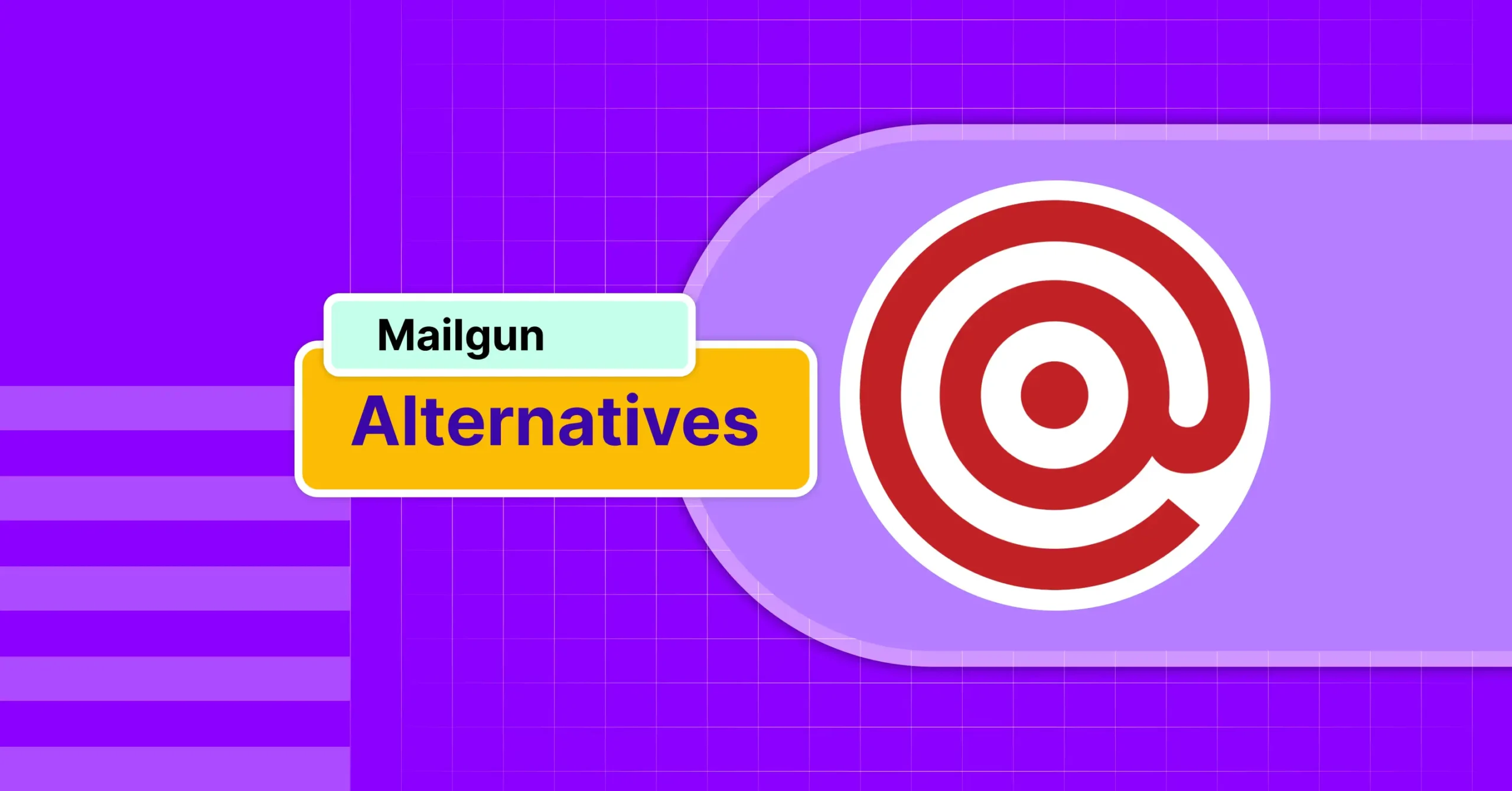
8 Best Mailgun Alternatives for Transactional & Marketing Emails in 2025
Mailgun is a leading email automation service designed specifically for developers to send transactional and marketing emails easily.
If you are a developer, then you know how important it is to have a reliable, developer-friendly email service that ensures your emails get delivered promptly and securely, whether it’s order confirmations, password resets, or newsletters.
That’s why you often seek alternatives due to pricing concerns, unique feature needs, or specific use cases that Mailgun may not fully address.
So, in this article, you’ll discover 10 top Mailgun alternatives that focus on powerful APIs, scalable infrastructure, and developer-focused features.
So, let’s start.
Mailgun Alternatives: A Quick Overview
Before diving into the details, here’s a quick look at some alternatives to Mailgun among the best transactional email services for different needs:
| Tool | Best For | Key Features (Short) | Pricing (Starting) | Free Plan |
| SendGrid | Developers & marketers needing both email types | API + SMTP, marketing tools, deliverability suite, webhooks, analytics | $19.95/month for 50K emails | Free trial for 60 day, 100 emails/day |
| Postmark | High-speed transactional emails | Instant delivery, message streams, analytics, dedicated IP, templates | $15/month for 10K emails | 100 emails/month |
| Amazon SES | Scalable, budget-friendly email sending | API + SMTP, CloudWatch, deliverability monitoring, templates | $0.10 per 1,000 emails | 3000 emails/month |
| Brevo | Small teams needing all-in-one tools | Email + SMS, marketing automation, CRM, transactional API, SMTP | $9/month for 5K emails | 300 emails/day (~9,000/month) |
| Mailtrap | Developer and product teams | High email deliverability, separate transactional and bulk email streams, API + SMTP, dedicated IP | $15/month for 10K emails | 4,000 emails/month |
| Mailchimp | Marketers need a full-stack solution | API + SMTP, templates, integrations, analytics, transactional add-on | $20 for 25K transactional emails | 1000 email/month(Marketing only) |
| MailerSend | Startups & small teams | API + SMTP, dynamic templates, email verification, analytics, collaboration tools | $28/month for 50K emails | 3,000 emails/month |
| MessageBird | Developers needing deep analytics | Real-time analytics, API + SMTP, predictive inboxing, reputation tools | $20/month for 10k emails | 100 emails/day (~3,000/month) |
What to Look for in a Mailgun Alternative?
When evaluating alternatives to Mailgun, it’s crucial to consider what developers truly need for seamless email integration, reliable delivery, and long-term scalability. Here are the key features and pain points to keep in mind:
- API and SMTP Integration: Look for services that offer RESTful APIs and SMTP support, along with official SDKs for languages like Python, Node.js, PHP, and Go.
- Scalability: Your email solution should scale smoothly from a few hundred to millions of emails per month without a complete infrastructure overhaul.
- Deliverability Optimization: Support for SPF, DKIM, and DMARC is essential to ensure your emails land in inboxes, not spam folders.
- Analytics and Tracking: Real-time tracking of opens, clicks, bounces, and spam complaints helps you monitor performance and quickly address deliverability issues.
- Pricing Transparency: Transparent, flexible pricing (especially pay-as-you-go or generous free tiers) can make a big difference.
- Developer-Focused Documentation and SDKs: Well-written docs, clear email API references, and active developer support communities save hours of debugging and make onboarding painless.
8 Best Mailgun Alternatives for Developers & Marketers
So, it’s time to dive deeper into the top transactional email services, and you’ll see exactly why each of them is best. Whether you’re looking for better deliverability, affordable pricing, or a generous free plan, this comparison table will help you find the right fit.
SendGrid – A Developer-Friendly Email Delivery Platform by Twilio
SendGrid is a cloud-based email service owned by Twilio that helps developers and businesses send transactional and marketing emails at scale. It’s known for its powerful infrastructure, flexible APIs, and high deliverability, sending over 148 billion emails every month.

If you’re using Mailgun for transactional emails and want something that also offers built-in email design tools, marketing automation, and better team collaboration, SendGrid is worth checking out. It’s more of an all-in-one platform, while Mailgun stays focused on raw email delivery.
Key Features of SendGrid
- Flexible APIs and Libraries: RESTful API with JSON; supports major languages and quick integration using open-source SDKs
- Webhooks and Event Tracking: Real-time webhooks to track opens, clicks, bounces, and unsubscribes with detailed analytics
- Deliverability Tools: SPF, DKIM, DMARC support with dedicated IPs, domain authentication, and deliverability insights
- SMTP Integration: Universal SMTP relay available for teams not using the API
- Scalability: Sends from 100 to billions of emails monthly with a powerful Mail Transfer Agent (MTA) and smart queue handling
Pros and Cons
| Pros | Cons |
| Supports both marketing and transactional emails | Pricing grows fast with volume |
| Clean UI for managing templates and analytics | Free tier has limited support |
| High deliverability with robust reputation tools | Shared IP pools may affect inbox rates without an upgrade |
| Trusted by global brands like Uber and Airbnb |
Pricing
SendGrid offers a free trial on both the Email API and Marketing plan for 60 day and you can send up to 100 emails per day.
- Email API plans start at $19.95/month for 50,000 emails, in the Pro plan starts at $89.95 per month for 100,000 emails
- Marketing plans start at $15/month up to 100,000 contacts and send up to 300,000 emails per month
Bonus: For a details comparison between SendGrid and Mailgun, you can check our article on SendGrid vs Mailgun.
Postmark – Fast and Reliable Transactional Email Delivery
Postmark, now part of ActiveCampaign, is a transactional email service built with one mission: speed and reliability. It’s trusted by apps like Trello and Basecamp to deliver critical emails, like password resets and order confirmations, without delay.

If Mailgun is your go-to for deliverability, Postmark takes that focus and pushes it even further. While Mailgun supports marketing emails too, Postmark is all-in on transactional messaging, making it a great alternative if that’s your core need.
Key Features of Postmark
- Email API and SMTP: RESTful API and SMTP support with SDKs for Node.js, Python, Ruby, and more
- Deliverability Tools: Built-in SPF, DKIM, DMARC setup with optional dedicated IPs, and DMARC monitoring
- Real-Time Analytics: Tracks opens, clicks, bounces, spam; includes 45-day logs and event webhooks
- Testing and Debugging: Sandbox server for safe testing; supports inbound email processing
- Templates: Manage dynamic templates via API or UI for personalized transactional emails
- Instant Delivery: Prioritizes transactional emails for faster inbox placement
- Message Streams: Separates transactional and broadcast emails to boost deliverability
Pros and Cons
| Pros | Cons |
| Lightning-fast delivery for time-sensitive emails | No built-in tools for marketing emails |
| Consistent customer support across all pricing tiers | Pricing may be high for bulk senders |
| Great documentation and easy setup | Occasional reports of verification emails hitting spam folders |
| GDPR-compliant for handling EU customer data |
Pricing
Postmark offers a free developer plan with 100 emails/month, which is great for testing.
- Basic plans start at $15/month for 10,000 emails for solo developers or small teams
- Pro Plans start at $60.50 per month for 50,000 emails per month for start-ups and small businesses.
- The Platform plan starts at $138/month for 125,000 emails per month.
Amazon SES – Scalable and Cost-Effective Email Sending
Amazon SES(Simple Email Service) is a powerful cloud-based email sending service designed for developers and businesses that need to send large volumes of email at a low cost. It’s part of the AWS ecosystem, making it an ideal choice if you’re already using Amazon’s cloud services.

If Mailgun focuses on ease of use and robust API features, Amazon SES stands out for its scalability and affordability, perfect if you want to send bulk transactional or marketing emails without breaking the bank.
Key Features of Amazon SES
- High Deliverability: Uses a global network of trusted IP addresses to boost inbox placement
- Flexible Integration: Supports SMTP, API, and SDKs for seamless setup across platforms
- Event Tracking: Webhooks (via SNS) and CloudWatch integration for tracking email events (sends, deliveries, bounces).
- Reputation Dashboard: Monitors your sending statistics, bounces, complaints, and reputation
- Email Templates & Personalization: Create reusable templates with dynamic content support
- Dedicated IP Addresses: Optional dedicated IPs to improve deliverability further
- Compliance & Security: Includes built-in DKIM, SPF, and DMARC support for email authentication
Pros and Cons
| Pros | Cons |
| Extremely cost-effective, especially for high-volume sending | The interface and setup can be complex for beginners |
| Seamless integration with other AWS services like Lambda and S3 | Limited native email analytics compared to some competitors |
| Flexible sending options via SMTP or API | Customer support is primarily through paid AWS support plans |
| Strong focus on deliverability and sender reputation |
Pricing
- Amazon SES provides a free tier where you can receive up to 3000 emails per month for the first 12 months after you start using it.
- Beyond that, pricing starts at $0.10 per 1,000 emails sent.
- Additional fees apply for dedicated IP addresses ($24.95/month) and for receiving emails.
Bonus: Here is a deep comparison of Amazon SES vs Mailgun, you can check.
Brevo – Affordable All-in-One Platform for Email, SMS, and More
Formerly Sendinblue, Brevo offers a complete communication suite including email, SMS, marketing automation, CRM, and transactional email, all from one dashboard. It’s ideal for growing teams looking to manage campaigns and transactional messages under one platform.

While Mailgun focuses strictly on transactional delivery, Brevo adds marketing tools, CRM, and SMS, all at a more affordable entry point.
Key Features:
- Transactional Email API & SMTP: RESTful API and SMTP relay with SDKs for PHP, Python, Node.js, Ruby, and Java
- Real-Time Tracking & Webhooks: Monitors opens, clicks, bounces, and deliveries, with event webhooks for automation
- Deliverability Features: SPF, DKIM, DMARC support with dedicated IPs, domain warm-up, and real-time performance monitoring
- Marketing Tools: Drag-and-drop email builder, SMS campaigns, automation workflows, and WhatsApp messaging
- CRM & Contact Management: Built-in CRM with segmentation, contact scoring, and team collaboration features
Pros and Cons
| Pros | Cons |
| Free plan includes both marketing and transactional features | API performance may lag behind specialized services like Mailgun or Postmark |
| Excellent for small teams needing marketing + transactional tools | Limited template versioning and preview options |
| Easy setup with intuitive UI and developer-friendly APIs | CRM is basic compared to full-scale tools like HubSpot or Zoho |
| Includes SMS, WhatsApp, and push notifications in higher tiers |
Pricing:
- Free Plan: 300 emails/day (9,000/month) + core marketing features like email template, drag and drop editor, API, SMTP, Webhooks, etc
- Starter Plan: Starting from $9/month for 5000 emails per month.
- Business Plan: Starts from $18/month for 5000 emails per month with advanced features like (adds marketing automation, A/B testing, advanced reporting, and phone support)
Mailtrap – The All-in-One Email Platform Built for Developers
Mailtrap is a modern email delivery platform built for developers and product teams who need reliable sending, deep analytics, and clean infrastructure management. It combines a robust Email API and SMTP service with high inboxing rates and fast delivery, making it a powerful solution for transactional and bulk email sending.

While Mailgun leans toward high-volume infrastructure, Mailtrap stands out with its developer-friendly workflows, in-depth analytics, and deliverability tools that help your emails land where they’re supposed to. Its analytics dashboard gives a full “helicopter view” of your email performance, making it easy to pinpoint issues across mailbox providers, domains, and sending categories.
Key Features of Mailtrap
- Email API & SMTP Support: RESTful API and SMTP relay with simple integration, compatible with SendGrid, Mailgun, and more
- High Email Deliverability: Fast and reliable email delivery with separate streams for transactional and bulk emails
- Analytics & Logs: Monitor delivery rates, open/click performance, bounces, and access detailed logs for up to 30 days
- Deliverability Tools: Includes dedicated IPs, automatic IP warmup, suppression lists, and smart deliverability alerts
- Security & Compliance: Easy domain setup, DKIM/SPF, and built-in security checks
Pros and Cons
| Pros | Cons |
| Excellent inboxing and domain reputation control | More technically oriented, making it a better fit for users with some development knowledge |
| 24/7 email expert support | |
| Easy migration from Mailgun with step-by-step guides |
Pricing
Their Free plan includes 4,000 emails per month (up to 150/day), 100 contacts, and no Mailtrap branding. It’s a solid starting point for small teams, but it comes with some limits, like only one domain, 3-day log retention, and a single user seat.
If you’re ready to scale or need access to advanced features, here’s how the paid plans break down:
- Basic Plan: $15/month for up to 10,000 emails. Ideal for small teams that need more flexibility. You’ll get additional user seats, click tracking, IP whitelisting, and user management tools. Plus, it includes contact storage for up to 50,000 recipients.
- Business Plan: $85/month for up to 100,000 emails. The go-to choice for most growing teams. This plan includes all core features plus dedicated IPs, automated IP warm-up, and access to deliverability experts.
- Enterprise Plan: $750/month for up to 1,500,000 emails. Designed for high-volume senders. It includes everything from lower tiers, with additional perks like activity logs, content-free logging, and discounted overages (1,000 extra emails for $0.55).
Mailchimp – All-in-One Marketing with a Powerful Transactional Add-On
Now a part of Intuit, Mailchimp blends transactional email with advanced marketing tools. Its transactional engine (formerly Mandrill) lets developers send high-volume, automated emails like order confirmations or password resets, on top of marketing automation, CRM, and landing pages.

Mailchimp suits teams needing both transactional and marketing tools, while Mailgun focuses purely on developer-driven email infrastructure.
Key Features of Mailchimp
- Email API & SMTP: RESTful API and SMTP relay with SDKs for Python, PHP, Ruby, Node.js, and more
- Analytics & Webhooks: Real-time tracking for opens, clicks, and bounces via webhooks and campaign reporting
- Deliverability Tools: SPF, DKIM, DMARC, automated bounce handling, and dedicated IPs for large senders
- Integrations: 800+ integrations with Shopify, WooCommerce, Salesforce, and Google Analytics
- Testing & Compliance: Inbox previews (via Litmus) and GDPR/CASL tools for privacy and consent management
Pros and Cons
| Pros | Cons |
| Unified platform for both marketing and transactional emails | It may be overkill for devs needing only transactional tools |
| Developer-friendly API with solid documentation | Email logs are only stored for 30 days on standard plans |
| Pay-as-you-go credits for flexible transactional sending | Email logs only stored for 30 days on standard plans |
| Deep integrations with top eCommerce and CRM platforms | Past security incidents (now resolved) may concern some teams |
Pricing
- Free Plan: 1,000 monthly marketing emails to 500 contacts; transactional emails not included
- Transactional Email Plan: This plan is designed for the developer at $20 for 25,000 emails per month, requires Mailchimp plan (starts at ~$13/month)
- Marketing Plans: Essentials ($13 for 5000 emails)/month, Standard ($20 for 6000 emails)/month, Premium ($350 for 150,000 emails)/month.
MailerSend – Fast, Developer-Friendly Email & SMS for Modern Teams
MailerSend, built by the team behind MailerLite, offers transactional email and SMS delivery focused on simplicity, scalability, and team collaboration. It’s ideal for startups and small teams that want a quick setup with strong deliverability.

MailerSend emphasizes ease of use and teamwork, while Mailgun is more geared toward raw power and advanced developer control.
Key Features of MailerSend
- API & SMTP Access: RESTful email API with SDKs for PHP, Node.js, Go, and more, plus flexible SMTP support
- Email Verification: Built-in validation API to clean lists and reduce bounce rates
- Dynamic Templates: Use logic and variables inside drag-and-drop or code-based templates
- Analytics & Webhooks: Real-time tracking with custom domain analytics and event-based webhooks
- Team Collaboration: Multi-user access, domain-level settings, and workflow-friendly dashboard
Pros and Cons
| Pros | Cons |
| 3,000 free emails/month—great for testing and small projects | Fewer third-party integrations than top-tier competitors |
| Very fast integration and beginner-friendly interface | Advanced features like SMS require paid upgrade |
| Strong deliverability and reputation-managed IP pools | Not built for complex marketing without MailerLite |
| 24/7 human support on all plans (no bots!) |
Pricing
- Free Plan: 3,000 emails/month with Email API, SMTP relay, drag and drop email builder
- Starter Plan: Start at $28/month for 50,000 emails, 100 SMS per month
- Professional Plan: Start at $88/month with 50,000 emails, 150 SMS, 400 email verification credits per month
MessageBird (formerly SparkPost) – Powerful Email API for Developers
MessageBird (formerly SparkPost) is a robust email delivery service designed with developers in mind, much like Mailgun. It focuses on providing high deliverability and detailed analytics to ensure your emails reach the inbox.

Also, MessageBird powers email for big names like LinkedIn and Pinterest, making it a trusted option for scaling transactional and marketing emails. If you want a Mailgun alternative with deep analytics and strong API support, MessageBird is a solid choice.
Key Features of MessageBird
- Real-time Analytics: Detailed insights into email performance, engagement, and deliverability
- Email API & SMTP: Flexible integration options to fit any workflow
- Deliverability Tools: Predictive inbox placement and engagement tracking
- Template Management: Manage and test templates efficiently
- Advanced Security: Supports TLS encryption and DKIM/DMARC standards
Pros and Cons
| Pros | Cons |
| Comprehensive analytics for email optimization | Free tier is limited, focused on paid plans |
| Strong API with great developer tools and documentation | Can be complex for beginners without developer resources |
| High deliverability with advanced inbox placement technology | Pricing may be higher for small businesses or low-volume senders |
| Scalable plans suitable for startups to enterprises |
Pricing
- Starter Plan: 10,000 emails/month — $20/month
- Premier Plan: 300,000 emails/month — $205/month (includes overage fees)
- High Volume: 1 million emails/month — $525/month (Premier tier)
Make Sure Your Transactional Emails Hit the Inbox, Not Spam
When it comes to sending transactional emails from your WordPress site, deliverability is everything. That’s where FluentSMTP comes in.
FluentSMTP is a 100% free WordPress plugin that connects your site to top email delivery services like Amazon SES, Mailgun, SendGrid, Brevo, and more. It ensures your order confirmations, password resets, and other crucial emails actually land in your user’s inbox, not the spam folder.
With features like real-time email logging, multiple SMTP connections, and no sending limits, FluentSMTP gives you complete control over your email delivery, without the cost or complexity.
Start Sending Transactional Emails in a Smart Way with FluentSMTP!
Get the most powerful SMTP plugin for free and hit the recipient’s inbox with your WordPress emails

Choose Your Mailgun Alternative for Seamless Email Delivery
Finding the right email service depends on what matters most for your business—whether it’s smooth integration, reliable deliverability, cost-efficiency, or powerful marketing features. Here’s a quick rundown to help you pick the perfect alternative:
- If you need a robust API, scalable infrastructure, and a reliable all-in-one platform, you can use SendGrid.
- Use Postmark for fast and reliable transactional email delivery and ensure email deliverability.
- You can use Amazon SES if you’re sending emails at scale and want a budget-friendly, pay-as-you-go solution.
- You can switch to Brevo (formerly Sendinblue) for an intuitive interface with powerful marketing and transactional email support.
- You can try Mailchimp if you need a simple, beginner-friendly platform with marketing automation.
- You can use MailerSend if you want a modern, developer-friendly experience with flexible email API tools.
- Try Elastic Email if you’re looking for affordable plans with both transactional and marketing capabilities.
- Mailtrap for a safe and efficient way to test your emails during development.
Now, it’s up to you to pick the email provider that matches your project’s needs. Each option has its own strengths, and no matter which one you go with, you’re already one step closer to building a better email experience.

Ratul Ripon
I enjoy turning complex ideas into simple ones and engage with people through my writing. With a background in Oceanography, I create technical content that’s both easy to understand and interesting.
Table of Content
Subscribe To Get
WordPress Guides, Tips, and Tutorials












Leave a Reply